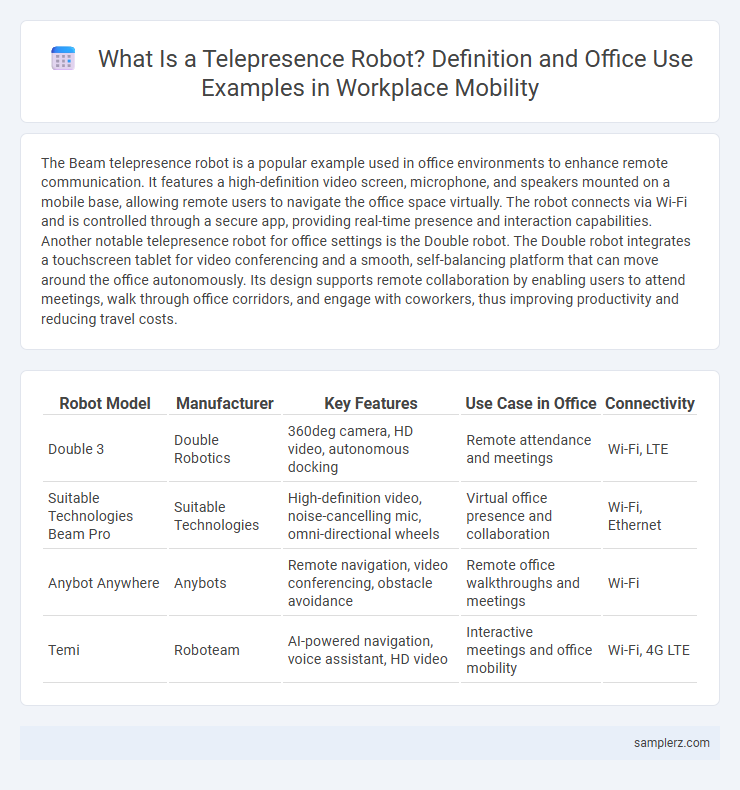The Beam telepresence robot is a popular example used in office environments to enhance remote communication. It features a high-definition video screen, microphone, and speakers mounted on a mobile base, allowing remote users to navigate the office space virtually. The robot connects via Wi-Fi and is controlled through a secure app, providing real-time presence and interaction capabilities. Another notable telepresence robot for office settings is the Double robot. The Double robot integrates a touchscreen tablet for video conferencing and a smooth, self-balancing platform that can move around the office autonomously. Its design supports remote collaboration by enabling users to attend meetings, walk through office corridors, and engage with coworkers, thus improving productivity and reducing travel costs.
Table of Comparison
| Robot Model | Manufacturer | Key Features | Use Case in Office | Connectivity |
|---|---|---|---|---|
| Double 3 | Double Robotics | 360deg camera, HD video, autonomous docking | Remote attendance and meetings | Wi-Fi, LTE |
| Suitable Technologies Beam Pro | Suitable Technologies | High-definition video, noise-cancelling mic, omni-directional wheels | Virtual office presence and collaboration | Wi-Fi, Ethernet |
| Anybot Anywhere | Anybots | Remote navigation, video conferencing, obstacle avoidance | Remote office walkthroughs and meetings | Wi-Fi |
| Temi | Roboteam | AI-powered navigation, voice assistant, HD video | Interactive meetings and office mobility | Wi-Fi, 4G LTE |
Introduction to Telepresence Robots in Modern Offices
Telepresence robots in modern offices enable remote employees to navigate and interact within physical workspaces through real-time video and audio streaming, enhancing communication and presence. These devices combine mobility platforms with high-definition cameras, microphones, and screens, allowing users to participate in meetings, collaborate with colleagues, and conduct walkthroughs without being physically present. Companies like Double Robotics and Suitable Technologies lead the market with models designed to improve productivity and foster inclusivity in hybrid work environments.
Enhancing Remote Collaboration with Telepresence Robots
Telepresence robots like Double Robotics and Suitable Technologies Beam revolutionize office environments by enabling remote employees to navigate physical spaces and engage in real-time interactions. These robots enhance remote collaboration through high-definition video streaming, two-way audio communication, and intuitive mobility controls that mimic in-person presence. Integrating telepresence technology significantly improves team productivity, employee engagement, and reduces the sense of isolation in hybrid and remote work models.
Leading Telepresence Robot Models for Office Environments
Leading telepresence robot models for office environments include the Double 3 by Double Robotics, which offers high-definition video conferencing and autonomous navigation. Suitable for remote collaboration, the Beam Pro from Suitable Technologies provides seamless mobility and real-time interaction with office teams. The Kubi Pro from Revolve Robotics enhances remote presence by enabling remote users to pan and tilt tablet-mounted cameras, improving communication efficiency in corporate settings.
Case Study: Telepresence Robots in Corporate Meetings
Telepresence robots have transformed corporate meetings by enabling remote employees to participate as if physically present, enhancing collaboration and decision-making. Case studies from multinational firms reveal a 30% increase in meeting engagement and a 25% reduction in travel costs after deploying these robots. This technology integrates high-definition video, real-time audio, and mobile navigation, creating a seamless virtual presence in dynamic office environments.
Improving Employee Inclusion with Telepresence Technology
Telepresence robots in office settings enhance employee inclusion by enabling remote workers to participate in meetings and collaborate in real-time, bridging geographical gaps. These robots provide a dynamic presence, allowing users to navigate the workspace, engage with colleagues, and attend events virtually. Organizations deploying telepresence technology report increased engagement, reduced feelings of isolation among remote staff, and improved overall team cohesion.
Cost-Benefit Analysis of Telepresence Robots in the Workplace
Telepresence robots in the workplace reduce travel expenses by enabling remote presence, lowering overall operational costs while maintaining employee engagement and productivity. Investing in models like Double Robotics or BeamPro offers scalable communication solutions that outweigh initial costs through decreased downtime and faster decision-making. Cost-benefit analyses demonstrate significant ROI by combining reduced office space requirements and enhanced collaboration across geographically dispersed teams.
Telepresence Robots Streamlining Office Tours and Client Visits
Telepresence robots enhance office tours and client visits by providing remote participants an immersive, real-time presence without physical travel. These robots integrate high-definition video, audio, and mobility features, allowing users to navigate office spaces seamlessly and interact with staff effectively. Companies like Double Robotics and Beam ensure efficient remote engagement, improving accessibility and saving time in corporate environments.
Overcoming Geographic Barriers Through Telepresence Solutions
Telepresence robots enable seamless remote collaboration by allowing employees to attend meetings and navigate office spaces virtually, overcoming geographic barriers. These robots enhance productivity by providing real-time audio-visual interaction, reducing the need for physical travel. Companies employing telepresence solutions report improved communication efficiency and inclusivity among distributed teams.
User Experiences: Telepresence Robots for Hybrid Teams
Telepresence robots in office environments enhance hybrid team collaboration by providing remote users with physical presence and mobility, allowing seamless participation in meetings and spontaneous interactions. Users report increased engagement and a stronger sense of connection compared to traditional video conferencing, as the robot's ability to navigate the workspace fosters dynamic communication and real-time responsiveness. This technology significantly improves remote team productivity and inclusivity by bridging the gap between virtual and on-site employees.
The Future of Telepresence Robots in Next-Generation Offices
Telepresence robots in next-generation offices enhance remote collaboration by providing mobile, interactive presence that bridges physical and virtual workspaces. Advanced sensors and AI-driven navigation enable seamless movement through office environments, improving accessibility and spontaneous communication. Integration with IoT systems in smart offices optimizes functionality, creating dynamic workspaces tailored to hybrid work models.

example of telepresence robot in office Infographic
 samplerz.com
samplerz.com